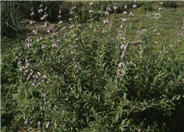
Common name:Blue Sage
Botanical name:Salvia 'Allen Chickering'
The Allen Chickering Sage is a perennial shrub that grows 2'-5' high and 2'-4' wide. It has blue flowers that bloom in the spring and summer. This shrub is native to California and is drought tolerant.
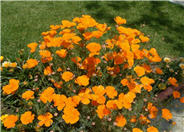
Common name:California Poppy, Golden Poppy
Botanical name:Eschscholzia californica
This small annual (sometimes acts as a perennial) plant will grow to less than 1' tall and has light, small blue green leaves with gold and orange flowers that bloom in spring and summer.
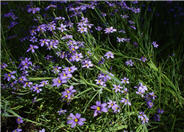
Common name:Blue-Eyed Grass
Botanical name:Sisyrinchium bellum
Following winter rains, this grassy perennial brings a soft texture back into the garden. It produces an abundance of small, blue purple flowers which have a long bloom.
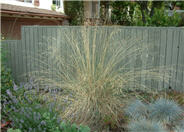
Common name:California Fescue
Botanical name:Festuca californica
The California Fescue is a cool season bunchgrass with blue green blades that reach 2'-5' high and 3' wide. Foliage arches gracefully upwards and outwards. Flower spikes reach 3' above the leaves. Plant in full sun or partial shade. It makes a great companion plant to oak trees and is handsome as a backdrop behind lower growing grasses for a meadow look. The California fescue is native to California and is a beneficial insect plant.
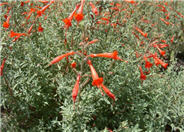
Common name:California Fuchsia, Zauschneria
Botanical name:Epilobium canum
The California fuchsia is a perennial with dense, narrow, green gray foliage and red orange summer flowers. The growth habit of this plant is sprawling and low. The California fuchsia is native to California, is drought tolerant, and attracts hummingbirds.
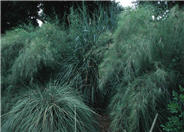
Common name:Bamboo Muhly
Botanical name:Muhlenbergia dumosa
The clumping grass grows to mature size of 6' tall by 5' wide. It is an easy to control grass that is drought tolerant, cold tolerant and accepts full sun. Flowering plumes appear fall and winter with purple spikes rising above the foliage. Leaves are chartreuse, fine and textured, creating a soft billowy effect. It spreads slowly by underground stems. It needs moderate to ample water but well drained soil. Cut back during spring when it begins growing; divide every 3-4 years.
| Designer: | Path of Discovery |
Photographer: GardenSoft |
Soils and Compost:
Incorporate compost 6" into your soil to retain water, reduce compaction, feed earthworms, and provide valuable nutrients to your plants.
Water Saving Tip:
Modify your controller each season. In the rainy season turn it off.
Integrated Pest Management:
Remove irrigation water and fertilizer from areas where you don't want weeds to grow.

